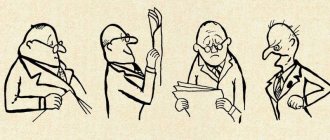Continuing the topic of personality typology, let me remind you that accentuation is a pronounced character trait that does not go beyond the norm of deviations in human psychology and behavior. Accentuation manifests itself to the greatest extent in certain unfavorable life circumstances for a person. This influences a person’s behavior and attitude towards others.
In the previous article, I described the classification of A. E. Lichko and mentioned that it is consonant with the classification of K. Leonhard, a German scientist and psychiatrist, they seem to complement each other. I will dwell on it in more detail.
Types of character accentuation according to K. Leonhard
Karl Leonhard (1904 – 1988)
The classification is based on an assessment of a person’s communication style with the outside world.
Stuck (rigid) type
Moderately sociable, prone to moralizing, taciturn. In conflicts, such a person usually acts as the initiator. Sensitive to social justice. He strives to complete the task he undertakes with high quality, to achieve high performance in any activity, placing increased demands on himself. Ambitious, jealous, sometimes overly arrogant. At work he places increased demands on his subordinates, and in the family he is also unreasonably demanding.
Excitable
It is characterized by low contact in communication, slowness of verbal and non-verbal reactions. They are often gloomy, boring, prone to abuse and conflicts, in which they themselves are an active and provocative party. They are very domineering in the family and discourteous in the team. If they are in a calm emotional state, they are conscientious and careful, they love animals and small children. However, in a state of emotional arousal, they have poor control over their behavior, are irritable and hot-tempered.
Demonstrative
Sometimes this type is called hysterical. People of this type easily establish contacts, strive for leadership, love power and praise. They quickly adapt to people, but are prone to intrigue, despite their outward softness. They irritate those around them with their self-confidence and high level of aspirations. As a rule, they themselves provoke conflicts, but at the same time actively defend themselves. People of this type are artistic, courteous, and extraordinary in their thinking and actions. People are repulsed by their negative traits: boasting, shirking from work, hypocrisy, selfishness.
Pedantic
Conscientious, serious, reliable, careful. They rarely enter into conflicts. At work, they make numerous formal demands on team members and behave like bureaucrats. Their formalism and grumbling greatly irritate those around them. The family is overly demanding of neatness and order.
Hyperthymic
Characterized by excessive contact and talkativeness. This type has pronounced gestures, facial expressions and pantomime. During communication, they deviate from the topic or change it. They don't tolerate comments. They are proactive, energetic, full of optimism, and thirst for activity. However, they are often instigators of conflicts, frivolous, and do not always conscientiously treat their responsibilities. They do not like loneliness, strict discipline and monotonous work.
Disthymic
He is characterized by low contact, taciturnity, and a dominant pessimistic mood. They are usually homebodies, avoid noisy companies and parties, and lead a secluded lifestyle. Easily enter into conflicts. Endowed with a thorough instinct, serious, conscientious. They have a keen sense of justice. The dysthymic type is characterized by slow thinking, passivity, clumsiness, and individualism.
Cycloid (cyclothymic, affectively labile, unstable)
Cycloids are characterized by frequent mood swings and arrogance in dealing with people. During periods of high mood, they are sociable; during periods of depressed mood, they are withdrawn. During times of elation, they behave like people with hyperthymic accentuation of character, and during periods of decline, they behave like people with dysthymic accentuation.
Exalted (affectively exalted)
People of this type are characterized by high contact, amorousness, and talkativeness. They often argue, but do not lead to open conflicts; in a dispute they can be both an active and passive party. They value their loved ones and friends, are very attached and attentive to them. They are prone to compassion, altruistic, have good taste, and are able to show bright and sincere feelings. Their negative traits: commitment to momentary moods, alarmism.
Anxious
This type is characterized by low contact, timidity, lack of self-confidence, and a minor mood often dominates. They rarely enter into conflicts with people, playing only a passive role in them. They are often targets of ridicule and scapegoats. They are friendly, self-critical, and efficient.
Emotive
People with this type of character accentuation prefer to communicate with a narrow circle of select people whom they understand perfectly. They play a passive role in conflicts and try to avoid them. They are touchy, but they carry grievances within themselves. Overly sensitive and tearful. They have concentration, a heightened sense of duty, and diligence.
Extroverted
They are distinguished by high contact, they have many friends and acquaintances. They are talkative, even chatty, and open to any information. They do not occupy leading positions in communication; they prefer to obey and be in the shadows. Performers are always ready to listen carefully to others. Negative traits: susceptibility to influence, thoughtlessness of actions, frivolity, passion for entertainment, prone to spreading rumors and gossip.
Introverted
They are characterized by very low contact, isolation, isolation from reality, and a tendency to philosophize. They conflict only in cases where others interfere in their personal lives. They love loneliness. They are principled, reserved, and have strong convictions. However, they are stubborn, rigid in their thinking, and tend to stubbornly defend their point of view or ideas, no matter what.
P.B. Gannushkin (1933) gave this type the name “constitutionally excited” and included it in the group of cycloids. However, this type was not subsequently identified in Soviet psychiatric literature and was usually included in the broader group of “excitables” [Kerbikov O.V., 1962].
Information from relatives indicates that from childhood, hyperthymic adolescents are characterized by great mobility, sociability, talkativeness, excessive independence, a tendency to mischief, and a lack of a sense of distance in relation to adults. From the first years of life, they make a lot of noise everywhere, love the company of their peers and strive to command them. Teachers of children's institutions complain about their restlessness. However, only in very rare cases is excitability in childhood so strong that it forces you to consult a doctor.
The first difficulties may appear when entering school. With good abilities, a lively mind, the ability to grasp everything on the fly, restlessness, distractibility, and lack of discipline are revealed. Therefore, they study very unevenly - sometimes they show off A’s, sometimes they “get” D’s. During puberty, motor excitability may smooth out, but character traits become even more pronounced.
The main feature of hyperthymic teenagers is almost always a very good, high spirits. Only occasionally and for a short time is this sunshine darkened by outbursts of irritation, anger, and aggression. The reason for indignation is usually opposition from others, the desire on the part of the latter to suppress too harshly the desires and intentions of a teenager, to subordinate him to someone else's will. Sometimes the reason for irritation is the awareness of too obvious one’s own mistakes and failures. Outbursts of irritation and anger become more frequent and intensified in a situation of a strictly regulated disciplinary regime, which hyperthymic adolescents tolerate very poorly, and also when they find themselves alone, deprived of society, wide contacts with peers, and the opportunity to apply the energy splashing out of them somewhere.
A good mood is harmoniously combined with excellent health, high vitality, and often a blooming appearance. They always have a good appetite and healthy sleep. Although they often sleep little, they get up cheerful in the morning. Under heavy physical exertion, lack of sleep, or in a tense situation that requires activity, energy, and resourcefulness, they retain strength for quite a long time. However, mental stress combined with forced idleness is poorly tolerated.
Acceleration in relation to general physical and sexual development is usually pronounced. By the age of 15-16, you can often see a fully formed adult figure.
Specific adolescent behavioral reactions in hyperthymic adolescents are quite pronounced. Due to the reaction of emancipation, conflicts easily arise with parents, teachers, and educators. This is led to by petty control, everyday obsessive care, constant instructions and moralizing, “working through” in the family and at peer meetings. All these measures usually only cause an increase in the “struggle for independence,” disobedience, and even a deliberate violation of rules and regulations. Trying to escape from the care of the family, hyperthymic teenagers willingly go to camps, go on tourist trips, etc., but even there they soon come into conflict with the established regime and discipline. As a rule, there is a tendency to unauthorized absences, sometimes for long periods. Real escapes from home are rare among hyperthymic people. And if they decide to escape, they tend to encourage one of their friends to escape in order to have a traveling companion. During escapes, their tirelessness, their ability not to get lost in unfamiliar places and unusual situations, to quickly establish contacts with strangers, to catch and dodge difficulties are especially evident. Attitudes towards rules and laws are less influenced by the emancipation reaction. It is more determined by frivolity than by the intention to violate them. The line between what is permitted and what is prohibited is visible. From their point of view, a tempting enterprise fully justifies “minor” run-ins with the law, and even the risk of being caught for obvious offenses.
The reaction of grouping is not only under the sign of constant attraction to peer companies, but also the desire for leadership in these companies. This desire is revealed as soon as the hyperthymic teenager has become at least a little accustomed to the society where he finds himself. When it comes to leadership in informal peer groups, hypertims usually achieve success. Their ability to always be ahead, their fearless readiness to resist at any time if necessary, to get into a fight, to take risks, to play with danger - all this is valued by their peers, who often give them the word “groovy guy.” They are at their best in organizing entertainment, and in any emergency situations where speed, courage and resourcefulness are required, and in an environment of work excitement, “emergency work”, “assault” - everything that creates a favorable opportunity for revealing the positive sides of their character.
However, in a closed institution for teenagers, with a strict regime, restriction of new contacts and the need for many days of round-the-clock communication between a closed circle of people, the too vigorous energy of hyperthyms, their constant desire to interfere everywhere and command everyone, begin to weigh down their peers, who lose sympathy for them [Bizyuk A.P. ., 1972]. Reacting with violent outbursts to the protests of other teenagers provoked by their own restlessness, they begin to constantly create a thunderous atmosphere around themselves and lose their leadership role.
An uncontrollable interest in everything around makes hyperthymic teenagers indiscriminate in their choice of acquaintances. Contact with random people they meet is not a problem for them. Rushing to where “life is in full swing,” they can sometimes find themselves in an unfavorable environment and end up in an asocial group. Everywhere they quickly get used to it, adopt manners, customs, behavior, clothes, fashionable hobbies. However, energy and emotionality do not allow hyperthymic adolescents to isolate themselves only within the framework of the interests and life of one group. Their liveliness encourages them to pay attention to much that is happening around them. Nevertheless, with friends they easily indulge in entertainment, drinking, even dubious adventures.
Hyperthymic adolescents are prone to group forms of delinquent behavior. Often they themselves become the instigators of group crimes, to which
They are driven not only by the thirst for entertainment or the desire to obtain means of pleasure - the element of risk is also attractive to them. “Prestige” among asocial peers is even more important.
Alcoholization poses a serious danger for hyperthymic individuals from adolescence. They always drink in company with friends. They prefer shallow euphoric stages of intoxication, but easily fall into the path of frequent and even regular drinking.
If the opportunity arises, they may show interest in other intoxicating drugs, especially “fashionable” surrogates, reassuring themselves with the thought that “this won’t make you an alcoholic or drug addict.” And, indeed, they remain for a long time at the level of “group mental dependence” [Strogonov Yu. A. Kapanadze V. G., 1978], which does not reach the level of substance abuse, both in relation to alcohol and other intoxicating drugs.
The reaction of hobby in hyperthymic adolescents is distinguished by its richness and variety of manifestations, but most importantly, by the extreme inconsistency of the hobby. Collections give way to gambling, one sporting hobby to another, one club to another. Boys pay fleeting tribute to technical hobbies, girls to amateur artistic activities. With a constant desire to command their peers, leadership hobbies (the role of official organizers, physical organizers, cultural organizers, elders, etc.) also do not attract them for long. Official leadership in formalized groups, apparently, is associated not so much with team functions, but with the need to perform everyday petty, painstaking work that requires perseverance and accuracy. This kind of work is always difficult for hyperthymic teenagers.
Accuracy is by no means their distinguishing feature either in their activities, or in fulfilling promises, or, what is especially striking, in monetary matters. They do not know how to calculate and do not want to; they willingly take on debt, pushing aside the unpleasant thought of subsequent repayment. They love to show off and easily embark on dubious adventures. An illegal transaction or petty theft in their eyes often does not have the character of a serious offense.
Reactions associated with the formation of sexual desire usually manifest themselves quite clearly. Sexual feeling awakens early and is quite strong.
This, as well as the lack of shyness and ease of contacts, push for early sexual relationships. Although romantic love does happen, it usually doesn't last long. A desire quickly arises to have sexual intercourse with the object of love. If this fails, then the love soon cools down, and the attraction is satisfied through casual acquaintances. Masturbation, as a rule, does not escape boys of this type, and they are not averse to joint masturbation with peers. But they are not inclined to be satisfied with this form of sexual activity and are looking for full-fledged intercourse. There is no particular tendency towards transient teenage homosexuality and other deviations of sexual desire.
Always a good mood and high vitality create favorable conditions for reassessing your abilities and capabilities. Excessive self-confidence encourages you to show yourself, appear before others in a favorable light, and boast. The latter sometimes leaves a hysterical imprint on the behavior of hyperthymic adolescents. But they are characterized by sincerity of enthusiasm, real confidence in their abilities, and not a strained desire to “show themselves more than they really are.” Falsehood is not in itself an inherent trait. Their lies are dictated by the need to get out of a difficult situation or are based on mixing their own optimistic ideas with reality. Everything new - new people, new places, new objects - attracts them keenly due to sincere interest and the desire to use their strengths, and not with the goal of just impressing others. The outlook on one's own future, as a rule, is full of optimism, even in the absence of any grounds for this. Failures can cause a strong affective reaction, but do not unsettle one for a long time.
The self-esteem of hyperthymic adolescents is quite sincere. In cases of accentuation not accompanied by pronounced behavioral disorders, most character traits are well noticed. But even with decompensated psychopathy, the ability to see the main hyperthymic traits in oneself remains - sociability, high spirits, etc., intolerance of loneliness and critical remarks addressed to oneself, a tendency to draw one’s own a future in rosy colors, a passion for adventure and risk, the attractiveness of the “first role” in a dangerous situation. Hyperthymic teenagers admit to the ease with which they can violate generally accepted rules and even laws for “interesting” and “tempting” things, and that they retroactively reproach themselves for this. Some features that are common to the unstable type are conscientiously noted - drinking in cheerful companies, absenteeism for the purpose of having fun. At the same time, sometimes there is a desire to imagine oneself more conforming to the environment than it actually is. This especially applies to sexual problems and relationships with parents, but to some extent it may also apply to other relationships. For example, “I like to dress like everyone else” is a fairly common response from hyperthymic people when assessing their attitude towards clothing. However, a conformist teenager means by this the most established styles for young people, and a hyperthymic teenager means the latest fashion. In assessing money matters, there is also an intention to show oneself more “correct” than one actually is. The tendency to run away from failure is rejected, although this usually happens quite often.
P.B. Gannushkin (1933) believed that hyperthymia often does not reach the level of obvious psychopathy. According to G. E. Sukhareva (1959), pronounced forms of hyperthymic psychopathy under the age of 15 years are extremely rare. According to our data, at the age of 14-18 years, hyperthymic accentuations and psychopathy are common. Among male adolescents hospitalized in a psychiatric hospital who were diagnosed with psychopathy or characterized by character accentuation (see Table 3), 10% of psychopathy and 13% of character accentuation were regarded as representatives of this type. In the general population, hyperthymic accentuation is also quite common - it occurs in 8% of male and 3% of female adolescents [Ivanov N. Ya., 1976].
Andrey L, 17 years old Since childhood, I have witnessed constant scandals between my alcoholic father and my mother, a powerful and energetic woman. As he remembers, he always wanted to leave home. He was always of a cheerful disposition, noisy, and tried to command his peers. He was a mediocre student, finished 8th grade and went to work. , choosing his mother’s profession (became a men’s hairdresser). He is considered a good master of fashionable hairstyles, is popular among young people in his area, and earns good money. He has many friends and makes acquaintances easily and quickly. Rapid puberty was also noted earlier. From the age of 14, he had a secret sexual relationship with a middle-aged woman and regularly met with her. She recently married someone else - he quickly consoled himself, became interested in his classmate, and is going to marry her.
When he was 15 years old, one day he came home and found the corpse of his father hanging himself and his mother lying unconscious and covered in blood - before committing suicide, out of jealousy, his father inflicted a severe wound on her head with an ax. He bravely endured a difficult situation, showing resourcefulness and energy.
The mother, having recovered, soon married someone else. He established, in his words, an “indifferent relationship” with his stepfather. He began to take care of his younger 10-year-old brother, buys him clothes with his own money, and monitors his studies at school (“his mother took care of his stepfather”).
From the age of 15, I began to drink often in the company of friends - recently up to a liter of wine at one time.
He was taken to a psychiatric hospital by ambulance at night with a picture of delirium. I saw rats running around the doctor’s table, there seemed to be “hordes of bedbugs” on the bed, there was a “nylon mesh” in front of my eyes, I heard someone screaming, I always felt that there was a cigarette squeezed between my fingers, I pulled it to my mouth, but when looked at the hand, the cigarette disappeared. At the same time, he was completely oriented and, in the pauses between hallucinations, critically assessed them. The physical condition was quite satisfactory. Apart from moderate tachycardia (90 per minute), mild facial hyperemia and dilated pupils, there were no other somatic manifestations of delirium. After the injection of chlorpromazine, I slept for more than 12 hours and woke up in clear consciousness. He said that the night before he was drinking wine in the company of friends and, at the suggestion of one of them, took several pills (“I think they start with the letter C...”). Friends said that “they make all sorts of devilish things happen” - I wanted to experience it for myself. In the middle of the night I woke up from terrible dreams. Then it began to seem that the room was filled with rats and bedbugs - he began to rush around and scream. Was hospitalized.
From the words of the younger brother, it became known that in recent months he had come home with friends several times in his mother’s absence - they smoked some kind of “dope” together, covered their heads with a blanket and sniffed something, and then laughed and got mad. The younger brother did not tell his mother anything, since he received handouts for silence. After this information was received, he admitted that he sniffed stain remover, took diphenhydramine, seduxen and cyclodol. The motive was the desire to experience something unusual. I did this once or twice a week when “there was nothing to do.”
Survey using PDO. According to the objective assessment scale, hyperthymic-unstable type was diagnosed. There are no signs indicating the possibility of psychopathy. There is a tendency to dissimulation, delinquent behavior and alcoholism. The reaction of emancipation is moderate, conformity is average. According to the subjective assessment scale, self-esteem is good: he considers himself to be a hyperthymic and unstable type, rejects melancholic and asthenoneurotic traits. Diagnosis. Suffered from intoxication (cyclodol) delirium. Mentally healthy. Behavioral disorders against the background of hyperthymic type accentuation.
Follow-up after 2 years. Serving in the Army.
Hyperthymia in its pure form most often occurs in the form of a clear accentuation of character. Against its background, transient behavioral disorders may occur (delinquency, alcoholism, less often - escapes and vagrancy), as well as neurasthenic reactions of the hypersthenic type [Lichko A. E., 1976.].
The formation of hyperthymic type psychopathy most often occurs through psychopathic development. At the same time, some features of the hyperthymic type, which also exist in a less pronounced form when accentuated, begin to come to the fore, creating similarities with other types of psychopathy.
Hyperthymic-unstable type. Among the variants of the hyperthymic type, this is the most common. The thirst for entertainment, fun, and risky adventures increasingly pushes one to neglect classes and work, to alcoholism, sexual excesses and delinquency - ultimately, all this can lead to an antisocial lifestyle. The core of the personality still remains hyperthymic and, despite all the external similarities with unstable adolescents, such adolescents are always distinguished by high vitality, optimism, keen interest in new things and, most of all, an undying desire for leadership, the role of leader, ringleader, initiator of the most risky adventures. In psychopathization of the hyperthymic-unstable type, the family usually plays a decisive role. Both hypoprotection, neglect, and dominant hyperprotection, petty control and strict dictatorship, aggravating the emancipation reaction, and even combined with the dysfunction of intra-family relationships, contribute to the development of this type of psychopathy based on hyperthymic accentuation. This path of psychopathic development is described in more detail in Chapter. V.
The hyperthymic-hysterical type is distinguished by the predominance of such character traits as the desire to boast, impress, show off in front of others, and show off. Often a tendency to mystifications is revealed, played out with great imagination, ingenuity, artistry, and a subtle sense of the weaknesses of the persons being misled. If a hysterical psychopath in the process of such hoaxes prefers to act as a “soloist actor”, then with the hyperthymic-hysteroidal variant he prefers the role of a “director”, forcing others to act in accordance with his plans. When faced with life's difficulties, failures, desperate situations and the threat of serious punishment, a tendency to demonstrative behavior is revealed, even to the point of depicting suicide attempts.
The formation of this type also occurs along the path of psychopathic development. The most important factor here is another type of improper upbringing - pandering hyperprotection, the “family idol” (see Chapter V).
Vladimir A., 17 years old. There was always a tense situation in the family. The mother is 10 years older than the father, is jealous of him for no reason, and made scenes in the presence of her son: she sent the boy to spy on his father. The father is gentle, indulgent, good-natured. According to him, the boy “learned to manage his parents from childhood,” benefiting from his mother’s jealousy, receiving gifts from both her and his father. He was always distinguished by his lively disposition, activity, and was amused when people believed him.
I studied well, English came easily, and I quickly learned simple dialogues. I tried sambo and motorsports, but soon gave up - I got tired of it. After graduating from school, he intended to enter the Military Medical Academy.
While studying in the last year of school, he unexpectedly found himself left to his own devices for some time - when his mother was being treated in a sanatorium, his father was sent on an urgent business trip. I fell into a group of teenagers who were gathering near hotels. He pretended to be a tourist from Canada, spoke to them only in English, pretending that he didn’t understand anything in Russian. He misled them, but a few days later he was accidentally exposed. He continued to get to know them, began drinking and skipping classes. To get money for drinks, he began to engage in petty speculation with foreign tourists. He was caught doing this and was expelled from school just before the final exams. I went to work at the post office, hiding it from my new friends, I was ashamed of this work, which was not “valued” among them. I went to drink more and more often—almost a bottle of wine at a time, but only in “my own company.” Intoxication led to “stormy fun” - although he did not get into fights, he was detained by the police more than once for making noise in public places. Casual sexual relations appeared. A year later, during a city-wide celebration of high school graduates, envying those who had graduated, he “went on a spree” - wandered around the city for almost three days, having fun and drinking, sleeping in fits and starts with friends. He was fired from work for absenteeism. Received a warning from the police. Then he declared that he wanted to “be treated for alcoholism,” and willingly entered a psychiatric clinic.
The mood at the clinic is high, he tries to impress the staff, and sends notes to his friends written in English. He quickly got used to the situation, claims to be a leader among teenagers, and treats the weak and sick with disdain. He is verbose, tries to present himself in a favorable light. He tends to overestimate his abilities - although he hasn’t studied for a year, he believes that he can easily pass the 10th grade and enter the academy.
Signs of alcoholism, even early ones, have not been established.
Physical development with acceleration. Neurological examination revealed no abnormalities.
Survey using PDO. According to the objective assessment scale, the hyperthymic type was diagnosed. There were no signs indicating the possibility of psychopathy. Conformity is average, emancipation reaction is moderate. A psychological tendency towards delinquency and a pronounced tendency towards alcoholism were discovered. According to the subjective assessment scale, self-esteem is satisfactory: hyperthymic and unstable features are reliably identified, features of sensitive and epileptoid types are rejected.
Diagnosis. Mentally healthy. Behavioral disorders against the background of character accentuation of the hyperthymic-hysteroid type.
Follow-up after 2 years. He is not registered with the dispensary. I tried unsuccessfully to enter college after finishing night school. Drafted into the army.
Hyperthymic-explosive type. The main manifestation of this type is that the outbursts of irritation and anger inherent in hypertimics, when they encounter opposition or fail, become especially violent and arise at the slightest provocation. At the height of affect, control over one’s behavior may be lost, abuse and threats are released without taking into account the situation, in aggression one’s own strengths are not commensurate with the forces of the object of attack, and resistance can reach “violent madness.” Acute affective reactions are usually of an aggressive type, but auto-aggression is also possible. The similarity of the hyperthymic-explosive type with the explosiveness of epileptoids remains purely external. Hyperthyms are easy-going, they have the ability to easily forgive insults, even to make friends with those with whom they were recently in a quarrel; other epileptoid features are also absent. It is possible that traumatic brain injuries, even mild but repeated ones, can play a significant role in the formation of the hyperthymic-explosive type. This type of psychopathization may also be a consequence of the malignant course of manic-depressive psychosis, which began in adolescence.
Mikhail!., 15 years old. Father and mother are divorced - both suffer from alcoholism. Until the age of 7, he was raised in the village by his grandparents in good conditions. But already at the age of 6-7 he was distinguished by a violent disposition, disobedience, without permission he left with older children to distant villages, and did not return to spend the night. At the age of 7, he was taken to the city by his father and stepmother, who treated him harshly and severely punished him for his misdeeds. Despite his good abilities, he was reluctant to study at school. He played in the streets until late and, fearing punishment, spent the night in the front door more than once. I met the soldiers: I secretly snuck into their barracks to spend the night. He left school at the age of 11. Sent to a boarding school, he ran away from there. At home he began to get into fights with his stepmother. It was easy to make acquaintances. More than once I disappeared somewhere for 10-15 days. He lived secretly with some praying woman for about a month, then he robbed her and ran away. He was placed in a children's psychiatric hospital, from where he was discharged to his mother, who had stopped drinking at that time. He also ran away from her, stole sweets, food, cigarettes from stalls, and took small money from children. One night he stole 200 packs of cigarettes from the cupboard. In the morning I saw the barmaid crying; I felt sorry for her - he returned everything to her.
At the age of 12 - a skull injury with loss of consciousness. After this, he became very irritable, quick-tempered, easily gets into fights even with stronger teenagers, but at the same time quickly moves away. He was sent to a summer sports camp for troubled teenagers, ran away from there to the city, at night climbed onto the second floor of a winery using staples, stole 15 bottles of wine, brought them to the camp and treated them to a friend. He has been drinking since the age of 13 - up to a bottle of wine or a glass of vodka at one time.
After escaping from the camp, he was again sent to a psychiatric hospital. In the teenage department, at the slightest provocation, he got into fights with other teenagers, quarreled with the staff, and at the same time gave violent but short affective reactions. He is in high spirits almost all the time, nervous, butts in everywhere, thereby irritating other teenagers. Khoronya is physically developed. Easy to make contact. Doesn't want to study.
Neurological “microsymptoms”, vasomotor play, and pronounced dermographism were noted. EEG showed no significant changes.
Survey using PDO. Hyperthymic-unstable type was diagnosed. A high B-index was noted, indicating a possible change in character according to the organic type, as well as a high level of psychological tendency towards alcoholism and conformity. According to the subjective assessment scale, self-esteem is satisfactory: the features of emotional lability, hyperthymia and instability are highlighted, only melancholic features are denied.
Diagnosis. Psychopathy of the hyperthymic-explosive type, severe, complicated by residual phenomena after traumatic brain injury.
Follow-up in a year Doesn't study and doesn't work. He disappears somewhere and rarely visits his mother. He was not detained by the police.
In conclusion, it should be mentioned that some hyperthymic adolescents in older adolescence and even more often in post-adolescence may begin to exhibit cycloid features. This transformation will be presented when describing the cycloid type.











